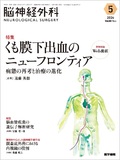Japanese
English
- 有料閲覧
- Abstract 文献概要
- 1ページ目 Look Inside
- 参考文献 Reference
Point
・脳神経外科技術が進歩している現在でも,巨大部分血栓化動脈瘤によるくも膜下出血の治療は難渋することが多い.
・症例を提示の上,本例における治療ストラテジーの考え方および技術的なTipsを詳述する.
・未破裂部分血栓化動脈瘤に対するflow diverterの有効性が報告されている.本例ではこのため,破裂急性期に破裂点を意識したコイル塞栓術で再破裂を予防して,スパズム期を乗り越えた後,flow diverterを留置した.
Despite advancements in neurosurgical techniques, subarachnoid hemorrhage(SAH)caused by the rupture of a partially thrombosed intracranial giant aneurysm remains a challenging clinical entity. This report describes the successful treatment of an 80-year-old male patient with SAH due to a ruptured, partially thrombosed intracranial giant aneurysm. The patient underwent a staged endovascular strategy using a flow diverter. The patient presented with SAH secondary to a ruptured, partially thrombosed intracranial giant aneurysm located at the C2 portion of the internal carotid artery and involving the origin of the posterior communicating artery(Pcom). Imaging revealed a dorsomedial rupture point on the aneurysm. A two-stage endovascular intervention(IVR)was performed. The first stage involved coil embolization aimed at covering the rupture point. Following the resolution of the vasospasm and the acute phase of SAH, the second stage involved the deployment of a pipeline embolization device. Digital subtraction angiography performed one month after the second stage IVR demonstrated a significant reduction in aneurysm filling, with preserved flow to the Pcom artery. We will discuss the technical details and rationale behind the staged endovascular approach in this complex case.

Copyright © 2024, Igaku-Shoin Ltd. All rights reserved.


